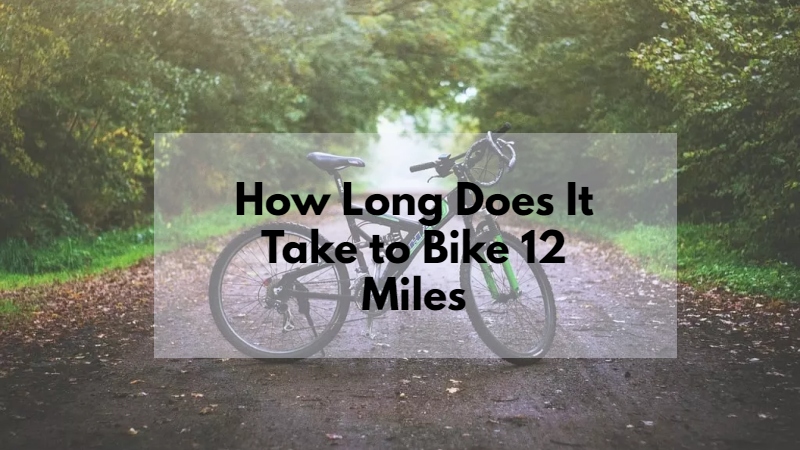“How long does it take to bike 12 miles?” is a commonly pondered question among cyclists, both novices and seasoned riders alike. The answer, however, is not a straightforward one. It varies significantly depending on a multitude of factors such as your fitness level, the type of bike you’re using, the terrain, prevailing weather conditions, and traffic scenarios. This comprehensive guide will delve into these aspects to provide a clearer understanding of what to expect when you set out to cover this distance on two wheels.
Factors That Affect Biking Time
Fitness Level
The most immediate factor impacting your biking time is your physical fitness. An individual in prime condition can pedal faster and sustain a higher speed for a longer duration, significantly cutting down the time taken to cover 12 miles. Contrastingly, if you’re new to cycling or not in your best shape, expect to take longer, as your body may require more frequent breaks and a slower pace to complete the journey.
Type of Bike
The choice of your bike plays a super important role in determining how quickly you can cover 12 miles. Road bikes, known for their lightweight frames and aerodynamic design, are ideal for smooth, paved surfaces and can greatly enhance your speed and efficiency. On the other hand, mountain bikes, with their sturdy build and wider tires, are better suited for rough terrains but tend to be slower on paved roads.
Terrain
The nature of the terrain is a decisive factor. Flat terrains allow for consistent speed and less physical exertion, while hilly or uneven terrains demand more energy, often leading to slower overall speeds due to the additional effort required in ascending slopes and maneuvering through uneven paths.
Weather Conditions
Weather conditions can significantly impact your biking experience and time. High temperatures and humidity levels can lead to quicker fatigue, necessitating more breaks. Conversely, cold weather can stiffen muscles, making it harder to maintain a steady pace. Wind conditions, especially headwinds, can also slow you down and add to your travel time.
Traffic
Biking in areas with heavy traffic can introduce delays. Navigating through busy streets, adhering to traffic signals, and the need for heightened awareness in bustling environments can add to your travel time, as opposed to cycling in a traffic-free zone where you can maintain a steady pace without interruptions.
Tips for Making Your Bike Ride More Efficient
Choosing the Right Bike
Selecting the appropriate bike for the terrain you plan to tackle is super important. If your route is primarily on paved roads, a road bike will serve you best, while mountain bikes are preferable for off-road trails or rugged terrains. The right bike not only enhances your efficiency but also ensures a more enjoyable ride.
Appropriate Attire and Hydration
Wearing clothing that suits the weather conditions is super important. In hot climates, opt for light, breathable attire and ensure adequate hydration throughout your ride. In colder conditions, layering up to maintain body warmth is advisable. Always carry water to stay hydrated, irrespective of the weather.
Route Planning
Pre-planning your route can save you time by avoiding getting lost and reducing the need for backtracking. Utilize mapping tools or apps to chart the most efficient course, considering factors like terrain, traffic, and distance.
Pacing and Warming Up
Start at a comfortable pace to warm up your muscles, gradually increasing intensity. A good warm-up reduces the risk of injury and makes your ride more enjoyable. Listen to your body and increase your pace as you feel more comfortable.
Break Management
While it’s important to take breaks, especially if you’re feeling tired or dehydrated, try to keep them concise to maintain a good overall time. Use breaks effectively for quick rests, hydration, or nutrition.
Ride Safely
Always be cognizant of your surroundings, obey traffic rules, and be mindful of pedestrians and other cyclists. Safety should always be your top priority.
Sample Biking Times
Various factors influence how long it takes to bike 12 miles, and one’s experience level plays a significant role. Here’s an estimation of the time it might take for cyclists of different skill levels and terrains:
- Beginner Cyclist on Flat Terrain: Approximately 60 minutes. Beginners often maintain a slower pace to ensure safety and comfort.
- Intermediate Cyclist on Flat Terrain: Around 50 minutes. Intermediate riders, with better stamina and skill, can navigate the same distance more swiftly.
- Advanced Cyclist on Flat Terrain: About 45 minutes. Advanced cyclists, owing to their superior fitness and efficiency, can complete the distance in a shorter time frame.
- Beginner Cyclist on Hilly Terrain: Roughly 75 minutes. Hills add a significant challenge, requiring more effort and thereby increasing the time taken.
- Intermediate Cyclist on Hilly Terrain: Estimated 65 minutes. While more adept at handling hills than beginners, intermediate cyclists still require additional time for such terrains.
- Advanced Cyclist on Hilly Terrain: Approximately 55 minutes. Advanced riders can tackle hills more effectively but will still find them more time-consuming compared to flat terrains.
This part of the blog post is continued in the next section, where we will explore how to train to improve your biking times, followed by super important safety advice, and finally, we’ll conclude with some key takeaways and a link to our homepage for more insights and cycling tips.
Training to Improve Your Biking Time
Regular Riding
The cornerstone of improving your biking time is consistency. Regular cycling builds endurance, strengthens muscles, and enhances cardiovascular health, all of which contribute to better performance. Aim to ride several times a week, gradually increasing the duration and intensity of your rides.
Long-Distance Rides
To boost your stamina and endurance, incorporate longer rides into your routine. These rides challenge your body to adapt to sustained periods of exertion, improving your ability to maintain a steady pace over longer distances, such as the 12-mile mark.
Hill Training
Hills are natural resistance trainers. Including hill rides in your training regimen enhances your leg strength and cardiovascular fitness, two super important components for reducing your overall biking time. Start with gentler slopes and progressively tackle steeper hills as your strength and confidence grow.
Interval Training
Interval training, which alternates between high-intensity and low-intensity cycling, is highly effective for improving speed and overall fitness. For instance, you might sprint for a minute followed by a few minutes of relaxed pedaling, repeating this pattern throughout your ride. This method helps increase your anaerobic threshold, allowing you to maintain higher speeds for longer durations.
Safety Tips for Biking
Helmet Use
Wearing a helmet is non-negotiable. A well-fitted helmet significantly reduces the risk of head injuries in the event of an accident. Ensure your helmet meets safety standards and is correctly adjusted to fit your head.
Adherence to Traffic Laws
Respect traffic signals and signs, and always yield to pedestrians. Riding predictably and following the rules of the road reduces the risk of accidents and ensures a safer environment for everyone.
Situational Awareness
Stay alert to your surroundings. This includes being mindful of other road users, anticipating possible dangers, and being prepared to react appropriately. Avoid distractions like using headphones or mobile phones while riding.
Use of Hand Signals
Hand signals are an super important communication tool for cyclists. Clearly signaling your intentions to turn or stop informs other road users of your actions, enhancing safety for everyone.
Regular Bike Maintenance
Keeping your bike in top condition is super important for a safe and efficient ride. Regular maintenance, including checking brakes, tires, and gears, ensures your bike performs at its best and reduces the likelihood of mechanical failures.
Conclusion
In conclusion, the time it takes to bike 12 miles can vary widely based on factors like fitness level, bike type, terrain, weather, and traffic. By understanding these factors, training appropriately, and prioritizing safety, you can improve your cycling performance and enjoy your rides to the fullest. Remember, cycling is not just about the destination or how quickly you get there; it’s also about the journey and the countless benefits it brings to your life.
For more insights on cycling and to explore a wide range of bikes and accessories, visit us at Refried Cycles. Whether you’re a beginner or an experienced cyclist, we have something to enhance your cycling experience.









